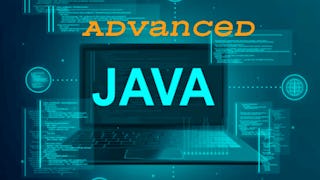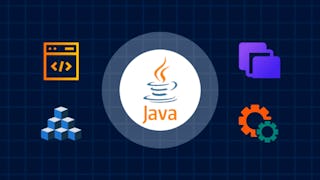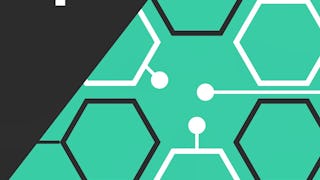This course equips learners with the practical skills and conceptual knowledge required to design, structure, and integrate modern web applications using a range of foundational and advanced technologies. Through progressive modules, learners will begin with the basics of XML and Core Java, gradually building toward hands-on implementation of HTML, CSS, and JavaScript for web interface design.



Expérience recommandée
Compétences que vous acquerrez
- Catégorie : Cascading Style Sheets (CSS)
- Catégorie : Hibernate (Java)
- Catégorie : Web Development
- Catégorie : Hypertext Markup Language (HTML)
- Catégorie : Service Oriented Architecture
- Catégorie : Web Design
- Catégorie : Model View Controller
- Catégorie : Java Platform Enterprise Edition (J2EE)
- Catégorie : Javascript and jQuery
- Catégorie : Scripting
- Catégorie : Ajax
- Catégorie : Middleware
- Catégorie : Java
- Catégorie : Web Applications
Détails à connaître

Ajouter à votre profil LinkedIn
juillet 2025
21 devoirs
Découvrez comment les employés des entreprises prestigieuses maîtrisent des compétences recherchées

Il y a 6 modules dans ce cours
This module introduces learners to the fundamental concepts of XML and its integration with Java. Through a progressive approach, students explore the basics of Java programming, object-oriented principles, and the role of XML in data interchange and configuration. The module concludes with an overview of enterprise application development using J2EE and the Model-View-Controller (MVC) design pattern, laying a solid foundation for advanced web application development.
Inclus
10 vidéos4 devoirs
This module explores foundational web technologies used in enterprise-level Java applications, focusing on the server-side processing and data communication layers. Learners are introduced to Java Servlets for dynamic content handling and to middleware concepts, particularly the role of Enterprise JavaBeans (EJB) in distributed systems. The second half of the module deepens understanding of XML, its role in SOAP-based web services, and the critical components and structures that ensure effective communication between systems. Through these lessons, learners build a strong base in how modern Java-based applications manage data and business logic across web platforms.
Inclus
6 vidéos3 devoirs
This module provides a comprehensive introduction to the foundational elements of web development. Learners explore how web technologies work, starting with the basic client-server model and moving into key web design principles used in creating user-centered websites. The module also covers the structure and syntax of HTML, emphasizing practical implementation techniques such as inserting images, designing layouts, and embedding content using frames. By the end of this module, learners will have a clear understanding of how to structure and present web content effectively using HTML and best practices in web design.
Inclus
10 vidéos4 devoirs
This module introduces learners to the foundational concepts and techniques of Cascading Style Sheets (CSS) for styling web pages. It begins with the importance of CSS in modern web development and explores how CSS enables consistent and efficient control over the presentation layer. Learners will understand essential rules and structures for applying styles, including the use of selectors, declarations, and positioning. The module also covers core concepts such as the CSS Box Model and relative layout adjustments, culminating in practical applications like subscript rendering and design precision. By the end of this module, learners will be able to apply CSS to enhance the visual structure, consistency, and responsiveness of web interfaces.
Inclus
5 vidéos3 devoirs
This module introduces learners to the dynamic aspects of modern web development by integrating client-side scripting and asynchronous communication. It begins with the principles of AJAX and the use of JavaScript and jQuery to communicate with web servers without reloading pages. The module also covers how to construct and handle XMLHttpRequests, explore source code interactions, and implement responsive web behavior. In the second half, learners will explore JavaScript fundamentals and how XML is used to structure and exchange data between systems. Through real examples and practical use cases, learners will gain the skills to build interactive, data-driven web applications.
Inclus
7 vidéos3 devoirs
This module explores advanced uses of XML in enterprise and web development environments. Learners will begin by examining practical XML applications such as RDF, metadata description, and domain-specific uses. The module then transitions into working with XML in Java frameworks like Hibernate and includes key topics like XML parsers, CDATA sections, and structural rules for well-formed XML. Finally, it covers integration with web services, focusing on SOAP messaging, WSDL specifications, and service discovery using UDDI. By the end of this module, learners will have the tools to apply XML in real-world integration scenarios, especially in Java-based and service-oriented architectures.
Inclus
13 vidéos4 devoirs
Obtenez un certificat professionnel
Ajoutez ce titre à votre profil LinkedIn, à votre curriculum vitae ou à votre CV. Partagez-le sur les médias sociaux et dans votre évaluation des performances.
En savoir plus sur Mobile and Web Development
 Statut : Prévisualisation
Statut : PrévisualisationLearnKartS
 Statut : Essai gratuit
Statut : Essai gratuitBoard Infinity
 Statut : Essai gratuit
Statut : Essai gratuitAmazon
 Statut : Essai gratuit
Statut : Essai gratuit
Pour quelles raisons les étudiants sur Coursera nous choisissent-ils pour leur carrière ?





Ouvrez de nouvelles portes avec Coursera Plus
Accès illimité à 10,000+ cours de niveau international, projets pratiques et programmes de certification prêts à l'emploi - tous inclus dans votre abonnement.
Faites progresser votre carrière avec un diplôme en ligne
Obtenez un diplôme auprès d’universités de renommée mondiale - 100 % en ligne
Rejoignez plus de 3 400 entreprises mondiales qui ont choisi Coursera pour les affaires
Améliorez les compétences de vos employés pour exceller dans l’économie numérique
Foire Aux Questions
Access to lectures and assignments depends on your type of enrollment. If you take a course in audit mode, you will be able to see most course materials for free. To access graded assignments and to earn a Certificate, you will need to purchase the Certificate experience, during or after your audit. If you don't see the audit option:
The course may not offer an audit option. You can try a Free Trial instead, or apply for Financial Aid.
The course may offer 'Full Course, No Certificate' instead. This option lets you see all course materials, submit required assessments, and get a final grade. This also means that you will not be able to purchase a Certificate experience.
When you enroll in the course, you get access to all of the courses in the Specialization, and you earn a certificate when you complete the work. Your electronic Certificate will be added to your Accomplishments page - from there, you can print your Certificate or add it to your LinkedIn profile. If you only want to read and view the course content, you can audit the course for free.
If you subscribed, you get a 7-day free trial during which you can cancel at no penalty. After that, we don’t give refunds, but you can cancel your subscription at any time. See our full refund policy.
Plus de questions
Aide financière disponible,



